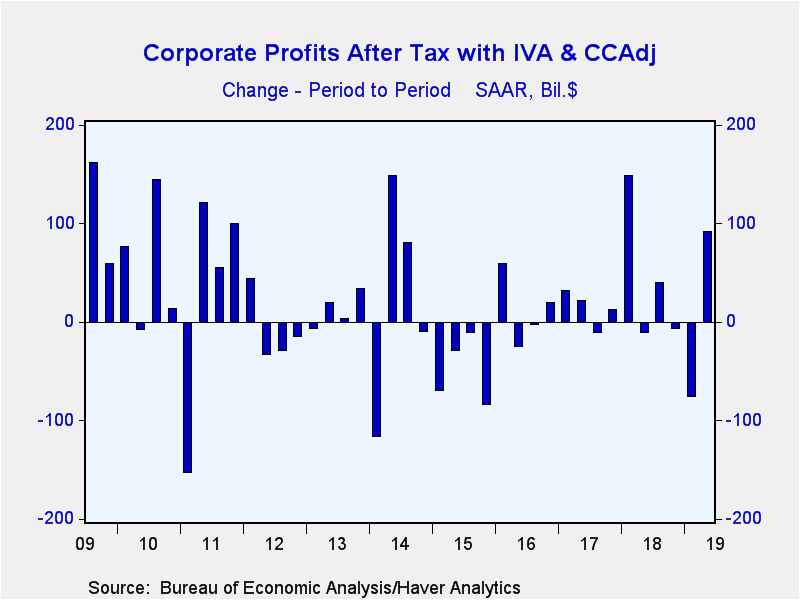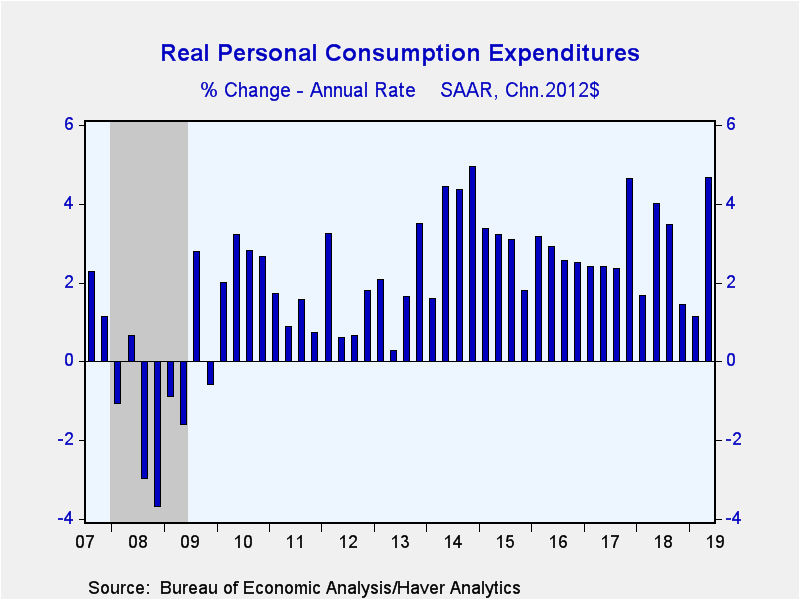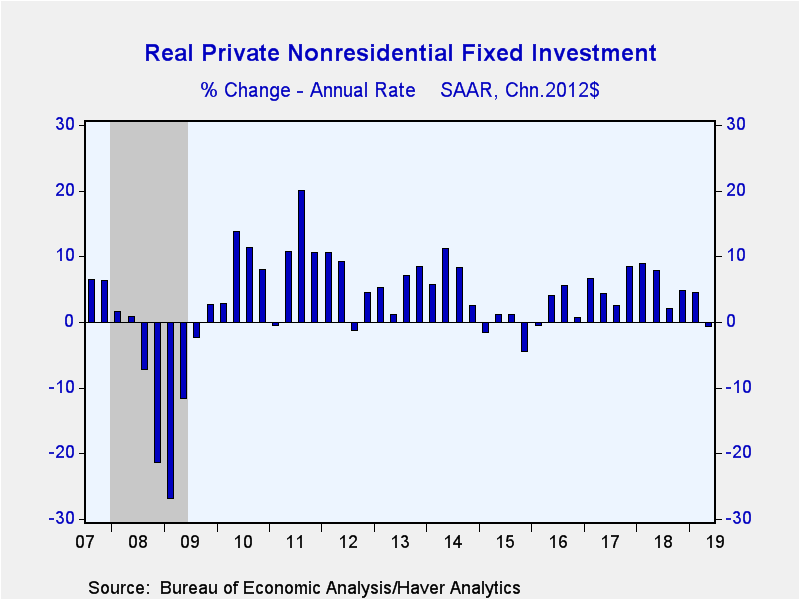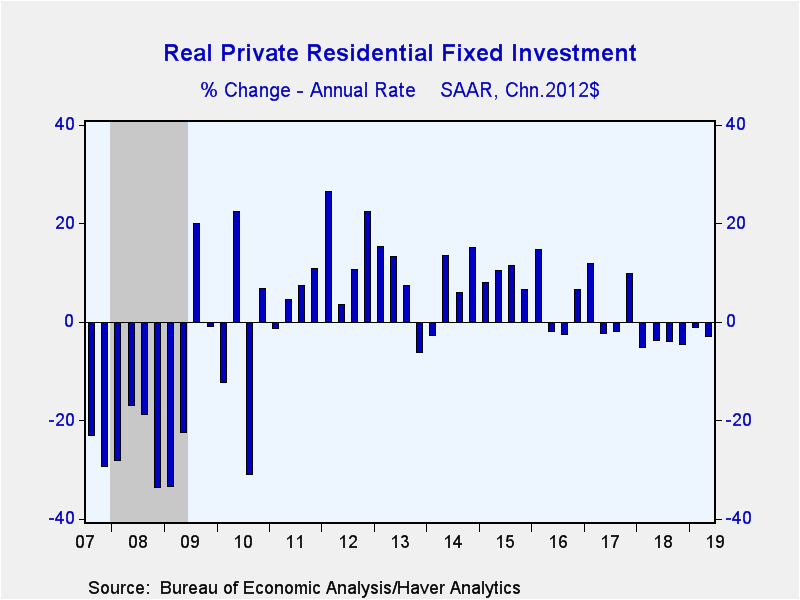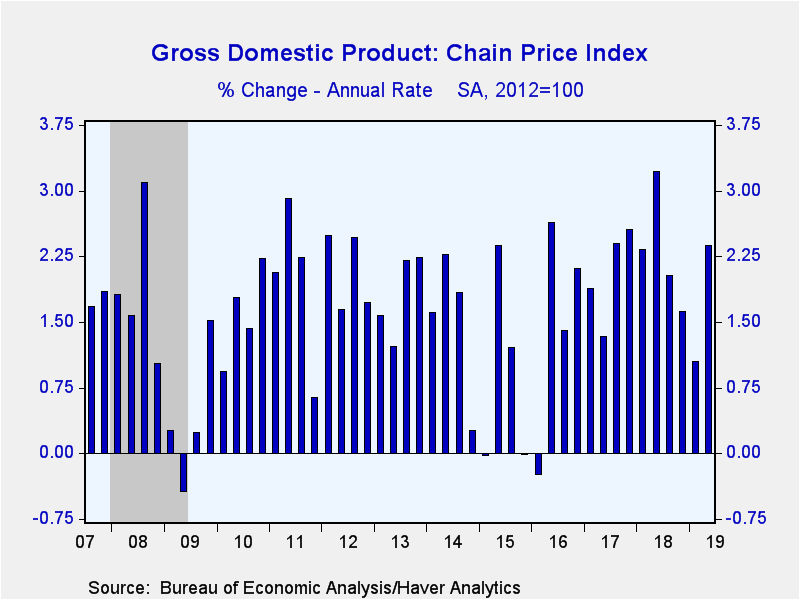 Global| Aug 29 2019
Global| Aug 29 2019Q2 U.S. GDP Growth Revised Down Slightly; Profits Rebound
by:Sandy Batten
|in:Economy in Brief
Summary
Gross domestic product, adjusted for price inflation, increased 2.0% q/q saar in 2019 Q2, revised down modestly from the initially reported 2.1%. This represents a slowdown from the 3.1% q/q increase in Q1. Compared with a year ago, [...]
Gross domestic product, adjusted for price inflation, increased 2.0% q/q saar in 2019 Q2, revised down modestly from the initially reported 2.1%. This represents a slowdown from the 3.1% q/q increase in Q1. Compared with a year ago, the pace of GDP growth slowed to 2.3% y/y (unrevised) in Q2 from 2.7% in Q1. The slight downward revision was spot on the market expectation from the Action Economics Forecast Survey.
This release contained the first look at NIPA corporate profits for Q2. After-tax corporate profits with inventory and capital consumption adjustments increased $105.8 billion (5.3% q/q) in Q2, their first increase in three quarters, following a $78.7 billion decline in Q1. Domestic profits rebounded, rising $47.4 billion (3.1% q/q) in Q2 after an $86.0 billion drop in Q1. Profits earned abroad also rose in Q2, increasing $58.3 billion (11.7% q/q) on top of a $7.3 billion rise in Q1.
The composition of overall GDP growth in Q2 was little revised. Personal consumption expenditure continued to do most of the heavy lifting. Indeed, PCE growth was revised up to a stellar 4.7% q/q saar from 4.3% in the advance report. This boosted PCE’s contribution to 3.1%-points from 2.9%-points and was the strongest quarterly gain in PCE since 2014 Q4. Nonresidential fixed investment was unrevised while residential investment was revised lower to -2.9% q/q saar from -1.5%, thereby increasing its drag on growth to 11 bps from 6 bps. Government spending growth was revised down to 4.5% q/q from 5.0%, reflecting a downward revision to state and local government spending. This lowered its contribution to overall GDP growth to 77 bps from 85 bps. The major drags on GDP growth in Q2 continued to be a growing trade deficit and slower inventory building. The real trade deficit (net exports) widened to $982.5 billion (2012$) from the initially reported $978.7 billion. This increased the drag from trade to 72 bps from 63 bps. Inventory building was revised down to $69.0 billion from $71.7 billion, increasing its drag slightly to 91 bps from 86 bps initially.
Growth in final sales (that is, GDP less impact of inventory change) was unrevised at a solid 3.0% q/q, its fastest pace of increase since 2018 Q2. This was led by the strong performance of PCE and reflected strong gains in each of the major components (durables, nondurables, services). Of particular note was the 6.8% q/q jump in spending on nondurable goods (revised up from 6.0%), the largest quarterly gain since 2003 Q3. Growth of domestic final sales (that is, GDP less impact of inventories and trade) increased 3.6% q/q, the strongest performance in four quarters, up from the initially reported 3.5% gain.
Business nonresidential fixed investment remained lackluster, falling an unrevised 0.6% q/q. The weakness was concentrate in spending on structures, which fell 9.4% q/q (revised up slightly from the initially reported 10.5% decline). Inventory building, as noted above, was revised slightly weaker. However, the pace of inventory building in Q2 was generally in line with what is considered normal. So with consumer spending continuing to put in a stellar performance, a further meaningful slowdown in inventory building is unlikely. Residential investment spending continued to decline in Q2 and indeed the initially reported decline was revised even lower. It has fallen in each of the past six quarters.
Government expenditures still posted an above-normal 4.5% q/q gain in Q2 (revised down from 5.0%), boosted by a 16.0% q/q jump in federal government nondefense spending (initially 15.9%). The revision was due to a downward adjustment to spending by state and local governments—to 2.3% q/q from the initially reported 3.2%.
The 2.4% q/q saar increase initially reported for GDP chain price index was unrevised as was its 1.8% y/y advance. The same was true for the 2.3% q/q gain in the key PCE price index though the core reading (excluding food and energy prices) was revised down slightly to 1.7% from 1.8%. Prices of residential investment were revised up to a 1.6% gain from 1.4%. Still, the rate of residential price inflation has fallen in each of the past five quarters.
The GDP figures can be found in Haver’s USECON and USNA database. USNA contains virtually all of the Bureau of Economic Analysis' detail in the national accounts. Both databases include tables of the newly published not seasonally adjusted data. The Action Economics consensus estimates can be found in AS1REPNA.
| Chained 2012 $ (%, AR) | Q2'19 (Advance Estimate) | Q1'19 | Q4'18 | Q2'19 Y/Y | 2018 | 2017 | 2016 |
|---|---|---|---|---|---|---|---|
| Gross Domestic Product | 2.1 | 3.1 | 1.1 | 2.3 | 2.9 | 2.4 | 1.9 |
| Inventory Effect (%-point) | -0.9 | 0.5 | 0.1 | 0.5 | 0.1 | 0.1 | -0.3 |
| Final Sales | 3.0 | 2.6 | 1.0 | 1.8 | 2.8 | 2.3 | 2.2 |
| Foreign Trade Effect (%-point) | -0.7 | 0.7 | -0.4 | 0.5 | -0.2 | -0.2 | -0.2 |
| Domestic Final Sales | 3.5 | 1.8 | 1.3 | 2.3 | 3.0 | 2.5 | 2.4 |
| Personal Consumption Expenditure | 4.3 | 1.1 | 1.4 | 2.6 | 3.0 | 2.6 | 2.7 |
| Nonresidential Fixed Investment | -0.6 | 4.4 | 4.8 | 2.7 | 6.4 | 4.4 | 0.7 |
| Residential Investment | -1.5 | -1.1 | -4.6 | -2.8 | -1.5 | 3.5 | 6.5 |
| Government Spending | 5.0 | 2.9 | -0.4 | 2.4 | 1.7 | 0.7 | 1.8 |
| Chain-Type Price Index | |||||||
| GDP | 2.4 | 1.1 | 1.6 | 1.8 | 2.4 | 1.9 | 1.0 |
| Personal Consumption Expenditure | 2.3 | 0.4 | 1.3 | 1.4 | 2.1 | 1.8 | 1.0 |
| Less Food & Energy | 1.8 | 1.1 | 1.7 | 1.5 | 1.9 | 1.6 | 1.6 |
| Nonresidential Investment | 2.0 | 1.6 | -0.0 | 1.3 | 1.4 | 1.0 | -0.9 |
| Residential Investment | 1.4 | 2.6 | 2.5 | 2.6 | 5.6 | 4.5 | 3.5 |
Sandy Batten
AuthorMore in Author Profile »Sandy Batten has more than 30 years of experience analyzing industrial economies and financial markets and a wide range of experience across the financial services sector, government, and academia. Before joining Haver Analytics, Sandy was a Vice President and Senior Economist at Citibank; Senior Credit Market Analyst at CDC Investment Management, Managing Director at Bear Stearns, and Executive Director at JPMorgan. In 2008, Sandy was named the most accurate US forecaster by the National Association for Business Economics. He is a member of the New York Forecasters Club, NABE, and the American Economic Association. Prior to his time in the financial services sector, Sandy was a Research Officer at the Federal Reserve Bank of St. Louis, Senior Staff Economist on the President’s Council of Economic Advisors, Deputy Assistant Secretary for Economic Policy at the US Treasury, and Economist at the International Monetary Fund. Sandy has taught economics at St. Louis University, Denison University, and Muskingun College. He has published numerous peer-reviewed articles in a wide range of academic publications. He has a B.A. in economics from the University of Richmond and a M.A. and Ph.D. in economics from The Ohio State University.



